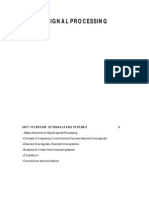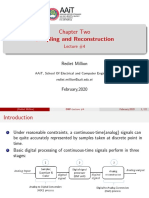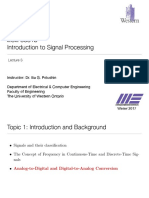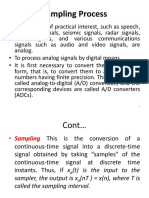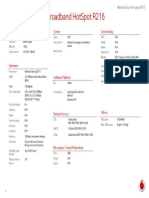0% found this document useful (0 votes)
167 views5 pagesDSP Lecture Notes for Students
This document discusses digital signal processing concepts including:
1. Converting analog signals to digital signals through sampling and the sampling theorem which states the sampling rate must exceed twice the highest frequency of the analog signal.
2. Finding the odd and even symmetry components of signals using formulas.
3. The concepts of periodic and non-periodic discrete-time signals and examples of determining periodicity.
4. Aliasing which occurs when a signal is sampled below the Nyquist rate and causes frequency components to overlap and distort the original signal.
Uploaded by
Lungelo MkhwanaziCopyright
© © All Rights Reserved
We take content rights seriously. If you suspect this is your content, claim it here.
Available Formats
Download as PDF, TXT or read online on Scribd
0% found this document useful (0 votes)
167 views5 pagesDSP Lecture Notes for Students
This document discusses digital signal processing concepts including:
1. Converting analog signals to digital signals through sampling and the sampling theorem which states the sampling rate must exceed twice the highest frequency of the analog signal.
2. Finding the odd and even symmetry components of signals using formulas.
3. The concepts of periodic and non-periodic discrete-time signals and examples of determining periodicity.
4. Aliasing which occurs when a signal is sampled below the Nyquist rate and causes frequency components to overlap and distort the original signal.
Uploaded by
Lungelo MkhwanaziCopyright
© © All Rights Reserved
We take content rights seriously. If you suspect this is your content, claim it here.
Available Formats
Download as PDF, TXT or read online on Scribd
/ 5


















